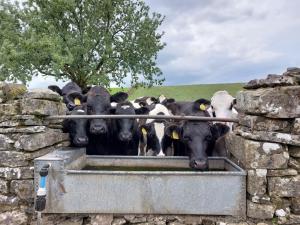
By Vet Chris Bailey
Historically, the three biggest challenges associated with dairy cow health and performance have been fertility, mastitis, and lameness. Over the last 20 years, significant improvements have been made in enhancing dairy cow fertility and mastitis control, but the levels of lameness have remained largely unchanged.

Lameness on dairy farms is undoubtedly one of the most frustrating issues to address. The most apparent concern with lame cows is the impact on animal welfare, but we cannot overlook its effects on staff morale, the industry's reputation, and financial costs.
There is substantial variation in the levels of lameness experienced on dairy farms. Some farmers manage to achieve remarkably low levels, with fewer than one in 20 cows experiencing lameness at any given time. Unfortunately, despite these success stories, recent estimates suggest that the average level in the UK is one in four cows experiencing some degree of lameness at any given time, with some herds experiencing even higher rates.
The Agriculture and Horticulture Development Board (AHDB) offers an excellent Mobility Mentor Program. This program, in collaboration with the farm's private vet, examines the causes of lameness on the farm and, together with the farmer, develops a plan and targeted interventions to help reduce the issue.
Controlling lameness can be divided into four main success factors. Depending on the causes of lameness on your farm - whether it's "white line disease, digital dermatitis, or sole ulcers" - different areas should be prioritised.
The first success factor is minimising infection pressure. This primarily focuses on reducing digital dermatitis, which is contagious and can spread from cow to cow. Once infected, a cow will carry it for life and go through periods of active infection and controlled infection. During active infection, she can transmit it to other cows. Controlling infection pressure may vary from farm to farm but involves promptly treating cows experiencing flare-ups, reducing contamination in passageways, and implementing effective foot bathing.
The second factor revolves around maintaining good hoof shape, horn quality, and digital cushion, aiming to reduce white line disease and sole ulcers. This involves monitoring the cow's diet, changes in body condition score over the calving period, and the technique and frequency of foot trimming.
Forces on the feet are crucial for controlling both sole ulcers and white line disease. Sole ulcers are associated with excessive standing. Critical areas to address include "cow cubicle stocking rates, cubicle comfort, and time spent away from cubicles." White line disease is more related to walking and pressured cow movement. It's vital to encourage gentle cow movements with ample space on a comfortable walking surface.
Regular mobility scoring is essential for reducing the level of lameness and monitoring progress. Mobility scoring involves having an independent and trained individual observe all the cows walking past and assign them a lameness score. The cows are scored from 0-3 with a score 2 cow having a lame leg identifiable and a score 3 cow can’t keep up with the herd with an arched back. Achievable targets would be less than 15% herd score 2 and less than 3% score 3.
Recent research has focused on the long-term effects of lameness events on the anatomy of a cow's foot. Even mild lameness events can trigger inflammation resulting in structural changes to the foot, making the cow more susceptible to future lameness events. Detecting lame cows quickly and providing effective treatment is key to reducing the cow's risk of going lame again.
The first step I would encourage all producers to take is to assess the number of lame cows on their farms. Do you have a lower level than the national average? Tackling lameness on the farm is challenging and will take time, requiring a comprehensive team approach. However, with the right interventions, achieving lower levels of lameness is attainable.